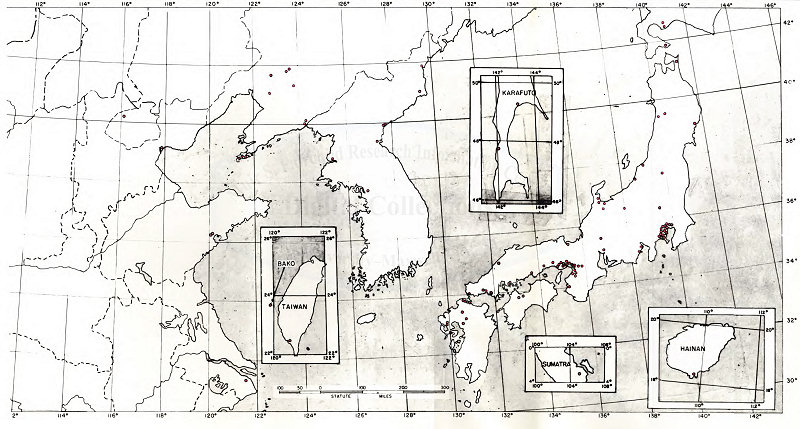
|
REQUIREMENTS FOR AIR ASCENDANCY Tab B Japanese Theatre - Summary of Systems |
|
Appendix |
System of Targets |
Number of Targets |
Percentage of Total Production Represented by Targets |
|
J I |
Aircraft and Engines |
14 |
78.1 |
|
J II |
Submarine Yards |
5 |
100 |
|
J III |
Naval and Commercial Bases |
20 |
99.2 (Naval) |
|
J IV |
Alumina and aluminum |
20 |
100 (Alumina) |
|
J V |
Iron and Steel |
21 |
100 (Iron) |
|
J VI |
Oil |
15 |
87 |
|
J VII |
Chemicals |
14 |
– |
|
J VIII |
Rubber |
14 |
100 |
|
Total Number of Targets |
123 |
||
|
NOTES: 1. The systems are arranged in the order in which it is suggested they be attacked. 2. The first system relates to the Japanese Air Force and is a combination of aircraft assembly and air engine plants. The destruction of the 14 targets named would reduce the aircraft building program of Japan’s to such a figure that she would be unable to support her Air Force for very long. 3. The second system relates to the Submarine Yards, which are few in number and small in size. 4. The third system relates to Naval and Commercial Bases, which covers ship building yards, repair yards, docks, ports and concentrations of shipping. It is considered that shipping is one of the most important items in the Japanese war program and for that reason an extremely heavy scale of attack is proposed against these objectives. The heavy interference in transportation which would result from successful attacks on shipping and ship yards would render Japan impotent to continue her war effort more rapidly than any of the individual remaining industrial objectives 5. The fourth group - Alumina and Aluminum - are of paramount importance to Japan, particularly in respect to her aircraft industry and the destruction of the plants proposed would have an immediate effect upon that industry. 6. The fifth group - Iron and Steel - are also of great importance to Japan and the destruction of the various plants proposed would have a great effect on her war effort. This industry can also be attacked indirectly by heavy attacks on shipping and transportation. 7. The three remaining systems - Nos. VI, VII and VIII - represent the three next most important industrial systems required for the Japanese war effort and the complete destruction of the various targets would have an immediate reaction thereon. 8. There is no doubt that if the targets included in these systems were successfully destroyed the effect would be decisive and Japan would be unable to continue her war effort. |
|||
|
Appendix |
System of Targets |
Total Number Sorties Required |
Operation Bomber Force Required |
Total Bomber Force Required |
||
|
B 17e |
B29 |
B 17e |
B29 |
|||
|
J I |
Aircraft and Engines |
4,800 |
66 |
10 |
88 |
14 |
|
J II |
Submarine Yards |
1,260 |
14 |
4 |
19 |
6 |
|
J III |
Naval and Commercial Bases |
22,440 |
298 |
46 |
397 |
62 |
|
J IV |
Alumina and Aluminum |
2,760 |
37 |
6 |
49 |
8 |
|
J V |
Iron and Steel |
9,060 |
118 |
19 |
158 |
25 |
|
J VI |
Oil |
7,920 |
105 |
16 |
140 |
21 |
|
J VII |
Chemicals |
1,920 |
27 |
3 |
36 |
4 |
|
J VIII |
Rubber |
1,320 |
19 |
3 |
25 |
4 |
|
TOTAL |
51,480 |
684 |
108 |
912 |
144 |
|
|
|
|
792 |
1056 |
|||
|
BOMBER FORCE |
||||||
|
|
B 17e’s |
B 29’s |
||||
|
Number of Groups |
19 |
3 |
||||
|
Number of Bombers per Group |
48 |
48 |
||||
|
Total Number of Bombers in class |
912 |
144 |
||||
|
Total Number of Bombers |
1056 |
|||||
|
Number of Operational Bombers |
684 |
108 |
||||
|
Total Number of Operational Bombers |
792 |
|||||
|
NOTES: 1. In calculating the number of bombers required to make a given number of sorties on a target area, one B 29 has been taken as equal to three B 17e sorties. 2. The number and weight of bombers required to be dropped on each target have been calculated according to the vulnerability and area of the target. They vary between 300 lbs. and 1000 lb. bombs. 3. The prosecution of this complete plan involves the dropping of about two hundred nine million (209,000,000) pounds of bombs. 4. This plan is to be carried out in a period of six (6) months during which sixty (60) days should be favorable for operations. |
||||||